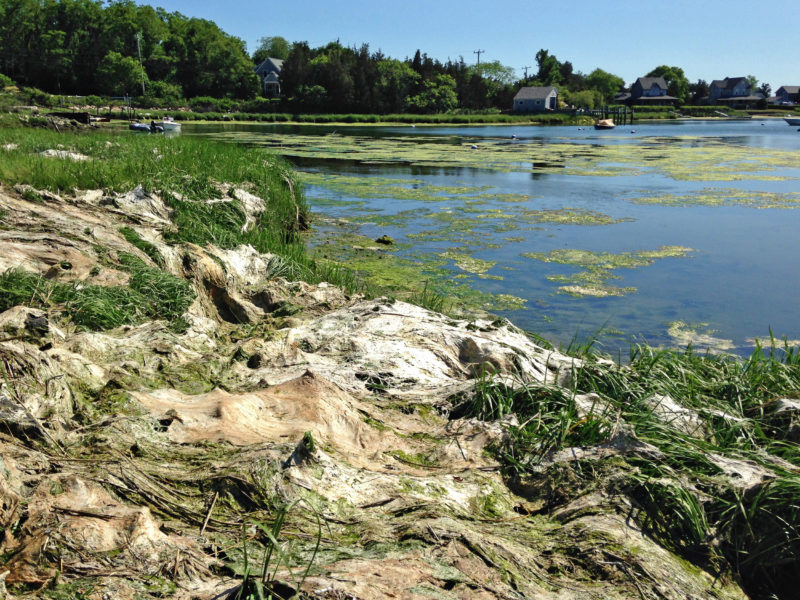Where are our TMDLs? After four years of waiting, Buzzards Bay waterways still don’t have promised state pollution limits
In July 2013, the Massachusetts Department of Environmental Protection (MassDEP) sent the Coalition and the Westport Fishermen’s Association a letter to assure us that they were paying attention to nitrogen pollution in the Westport Rivers. According to the letter, a final Westport Rivers TMDL would be complete by that winter.
But today, more than three and a half years later, we’re still waiting for the final pollution limits needed to take action to protect and restore the Westport Rivers.

When water is polluted with nitrogen, it becomes cloudy and murky with algae, and fish, shellfish, and eelgrass begin to disappear.
A TMDL, in case you’re not sure, stands for Total Maximum Daily Load. It details the greatest amount of pollution that a waterbody can accept and still meet clean water standards. TMDLs are created for waterways like the Westport Rivers when they don’t meet those clean water standards due to pollutants like nitrogen pollution, the greatest long-term threat to the health of Buzzards Bay.
As part of the federal Clean Water Act, each state must monitor and identify water bodies that do not meet clean water standards. These standards include things like supporting healthy fish and wildlife populations, clean swimming and boating conditions, and safe fish consumption. When waterways don’t meet these standards, MassDEP places them on a list called the Integrated List of Waters – sometimes called the “dirty waters list.” States must then develop TMDLs for waterways on this list so municipalities can address the pollution problem.
Altogether, there are 30 Buzzards Bay estuaries from Westport to Cuttyhunk that need TMDLs due to severe nitrogen pollution. As of today, only two have them.
We aren’t aware of any issues holding up final approval of the Westport Rivers TMDL. A draft was released for comment, the required public hearings and meetings with town officials were held, and everyone was notified that the final TMDL was imminent. The town of Westport invested significant public funds to support the development and issuance of this TMDL.
Westport isn’t the only community that’s waiting for a TMDL. Since 2013, MassDEP has been sitting on the scientific information they need to create TMDLs for several other Buzzards Bay estuaries including the Slocums/Little River in Dartmouth and Rands Harbor/Fiddlers Cove, Quissett Harbor, and Wild Harbor in Falmouth. That year, MassDEP approved final reports from the Massachusetts Estuaries Project that evaluate nitrogen in each estuary and the amount of pollution that needs to be reduced to meet clean water standards.
The longer it takes for the state to issue pollution limits, the worse the problem gets in our waterways – and the more expensive it’s going to be for our communities to solve it. The Westport Rivers and the Slocums/Little River have now been languishing on the state’s “dirty waters” list due to nitrogen pollution for an astonishing 15 years.
One of the spots on Buzzards Bay that has received a final TMDL is West Falmouth Harbor. Since the final West Falmouth Harbor TMDL was released in 2007, major progress has been made to restore the harbor. In 2012, the Coalition was able to defend the TMDL in court to secure strict pollution limits for the town’s upgraded wastewater treatment facility, which substantially reduced the amount of nitrogen that reaches the harbor. And in 2015, the Coalition partnered with the town to upgrade 20 home septic systems to nitrogen-reducing technology around the harbor; these new systems are already being shown to reduce an average of 88% of nitrogen compared to the old systems. The project, which was funded with an EPA grant, benefited from the fact that West Falmouth Harbor had an approved TMDL. Simply put, cleanup money flows more quickly to areas with TMDLs.
In a letter in January, we again urged MassDEP to release the Westport Rivers TMDL immediately and release the Slocums/Little River, Rands Harbor/Fiddlers Cove, Quissett Harbor, and Wild Harbor TMDLs later this year.
In response to our letter, last month MassDEP issued a new set of projected release dates for these reports. According to MassDEP, the final Westport Rivers TMDL was submitted to the EPA for approval earlier this month. The agency has also committed to issue the Slocums/Little River TMDL for public comment this spring and release draft TMDLs for Rands Harbor/Fiddlers Cove, Quissett Harbor, and Wild Harbor for public comment this summer.
Stay updated on this issue and be the first to know when these TMDLs are released by subscribing to our newsletter below and following us on Facebook.